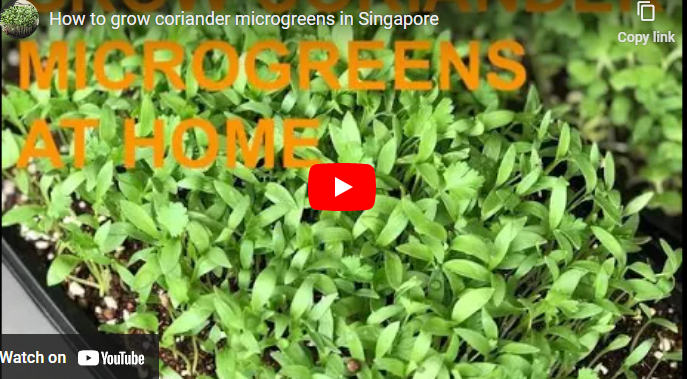Coriander, also known as cilantro or Chinese parsley, is a popular herb used in various cuisines around the world. It adds a fresh and vibrant flavor to dishes and is a staple in many Southeast Asian recipes.
Growing coriander in Singapore is an enjoyable and rewarding experience. Whether you have a spacious garden or a small balcony, you can cultivate this herb successfully with a few simple steps.
To grow coriander in Singapore, choose a location with partial shade and well-drained soil. Sow the coriander seeds directly into the soil or in a container, and keep the soil consistently moist. Harvest the leaves as needed once the plant reaches a mature size, usually within 6-8 weeks, and replant new seeds every few weeks to ensure a continuous supply of fresh coriander.
In this guide, we’ll explore the benefits of growing coriander, the selection of the right variety, ideal growing conditions, planting techniques, maintenance, and harvesting.
How to Grow Coriander in Singapore Step by Step Guide
Choosing the Right Variety
When selecting coriander seeds or seedlings, it’s crucial to choose the right variety that suits Singapore’s climate. Some popular varieties that thrive well in this region include Slow Bolt, Long Standing, and Santos. These varieties are known for their heat tolerance and resistance to bolting, ensuring a prolonged harvest period.
Selecting the Ideal Location
Coriander thrives best in a location that receives partial shade to full sun. It prefers a well-ventilated area that allows air circulation to prevent the onset of fungal diseases. Ensure that the chosen spot has well-drained soil to avoid waterlogging, which can harm the plant’s roots.
Soil Preparation
Prepare the soil before sowing the coriander seeds. Coriander prefers fertile, loamy soil with good drainage. Add organic matter such as compost or well-rotted manure to improve soil structure and fertility. Ensure the soil pH is around 6.0 to 7.0, which is slightly acidic to neutral.
Sowing Coriander Seeds
Sow the coriander seeds directly into the prepared soil or containers. Scatter the seeds evenly and lightly cover them with a thin layer of soil. Maintain a spacing of approximately 15 to 20 centimeters between each seed to allow ample room for growth. Water the seeds gently to keep the soil moist but not waterlogged.
Watering and Fertilizing
Coriander requires regular watering to keep the soil consistently moist. However, it’s essential to avoid overwatering, as excessive moisture can lead to root rot. Provide water whenever the soil feels slightly dry to the touch. During periods of intense heat, consider mulching around the plants to retain moisture.
Apply a balanced fertilizer, such as a slow-release organic fertilizer or a liquid seaweed solution, every four to six weeks to promote healthy growth. Avoid excessive nitrogen fertilizers, as they may cause the plant to produce more foliage rather than flavorful leaves.
Managing Pests and Diseases
Coriander is relatively resistant to pests and diseases. However, some common issues you might encounter include aphids, whiteflies, and fungal diseases like powdery mildew. Regularly inspect the plants for any signs of infestation or disease. Use organic insecticides or neem oil to control pests, and practice proper sanitation to prevent the spread of diseases.
Harvesting Coriander
Coriander leaves can be harvested when they reach a suitable size, usually around four to six weeks after sowing. Harvest the outer leaves by snipping them off with scissors or pruning shears, leaving the central growth intact.
This method allows the plant to continue producing fresh leaves. For seeds, wait until the flowers turn brown and dry on the plant. Cut the stems and hang them upside down in a paper bag to collect the seeds.
Storing and Using Fresh Coriander
To store fresh coriander, gently wash the leaves, pat them dry, and store them in an airtight container in the refrigerator. Alternatively, you can chop the leaves and freeze them in ice cube trays with a little water or oil for future use.
Fresh coriander adds a burst of flavor to various dishes, including curries, salads, soups, and marinades. Experiment with different recipes and enjoy the delightful taste of homegrown coriander.
Can I grow coriander indoors?
Yes, coriander can be grown indoors as long as it receives sufficient sunlight and proper care.
What is the best time to grow coriander in Singapore?
Coriander can be grown throughout the year in Singapore, but it thrives best during the cooler months.
How often should I water coriander plants?
Water coriander plants whenever the soil feels slightly dry to the touch. Avoid overwatering, as it can lead to root rot.
Can I grow coriander from cuttings?
No, coriander is typically grown from seeds rather than cuttings.
How long does it take for coriander seeds to germinate?
Coriander seeds usually germinate within 7 to 14 days under favorable conditions.
Conclusion
Growing coriander in Singapore is a rewarding endeavor that allows you to enjoy the freshness and flavors of this versatile herb. By following the step-by-step guide provided, you can cultivate coriander successfully, whether you have a garden or a small balcony.
Remember to choose the right variety, provide suitable growing conditions, practice proper watering and fertilization, and harvest the leaves and seeds at the right time. Enjoy the culinary delights of homegrown coriander and elevate your dishes with its distinctive taste.




